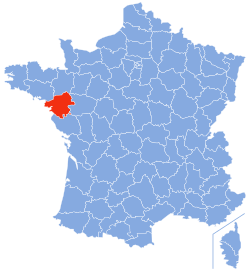On 22 December 2014, Sébastien Sarron ran over ten pedestrians in his white van at the Christmas market of the French city of Nantes, before attempting suicide by stabbing himself. Ten people, including the suspect, suffered non-fatal injuries. One man, Virgile Porcher, was pronounced clinically dead the following day.[1]
| 2014 Nantes attack | |
|---|---|
 The Place Royale Christmas market one year after the attack | |
 Location of Loire-Atlantique within France | |
| Location | Place Royale, Nantes, France |
| Date | 22 December 2014 |
| Target | Civilians |
Attack type | Vehicular assault |
| Weapons | White van |
| Deaths | 1 |
| Injured | 10 (including the suspect) |
| Victim | Virgile Porcher |
| Perpetrator | Sébastien Sarron |
| Motive | Suspected mental unbalance |
The attack came a day after a similar automotive attack on pedestrians in Dijon, as well as two days after a stabbing attack inside a police station in Joué-lès-Tours. Although the three attacks were treated as unrelated, the Government of France deployed 300 soldiers onto the nation's streets to heighten security afterwards.[2][3]
In 2016, the Financial Times described this attack, the 21 December 2014 Dijon attack, and the 20 December 2014 Tours police station stabbing as "the first ISIS-linked attacks" in France.[4]
Suspect
editFrench Interior Minister Bernard Cazeneuve said that the attacker in Nantes was "unbalanced".[2] There were initial reports that the attacker had shouted Allahu Akbar ("God is Great"), however, police stated that a notebook in his van contained "incoherent suicidal phrases",[5] and his fear of being murdered by the secret services.[6] A test found 1.80 g of alcohol per litre of blood, four times the maximum legal rate.[7][8]
The driver was Sébastien Sarron (38), a farmer from Berneuil near Saintes, Charente-Maritime.[9] After tending his wounds, he was transferred to a psychiatric hospital on 31 December.[7]
In January 2015 he was transferred to prison.[7] He was described as a loner, an alcoholic and paranoiac, but was declared by a psychiatrist as responsible enough to be tried.[1] He hanged himself in his isolation cell at the Nantes-Carquefou prison on the early morning of 13 April 2016.[1][6]
Motivation
editThe Financial Times described in a July 2016 piece this attack, the 21 December 2014 Dijon attack, and the 20 December 2014 Tours police station stabbing as "the first ISIS-linked attacks" in France.[4] According to The Globe and Mail, the attack was "apparently inspired by a video" circulated by ISIL calling on French Muslims to attack non-Muslims using vehicles.[10]
According to David C. Rapoport of the University of California, Los Angeles, these three attacks can be understood in the context of the rise of the Islamic State in Syria. "In September 2014, after the U.S. organized its airstrikes, the Islamic State’s chief spokesman called on Muslims in Western countries to find an infidel and ‘smash his head with a rock’, poison him, run him over with a car or ‘destroy his crops’. Two months later a video released in French contained virtually the same message, and a series of strange 'lone wolf' attacks followed on three consecutive days, the perpetrators declaring “'God is Great' in Arabic. Three policemen were stabbed in Joué-lès-Tours, and vehicles were used to run over eleven pedestrians in Dijon and ten in Nantes."[11]
Reaction
editThis section needs additional citations for verification. (February 2024) |
Interior Ministry spokesman Pierre-Henry Brandet announced an investigation into the Nantes attack, saying "I wouldn't say it was a terrorist attack. I would call it a deliberate act".
François Hollande, the President of France, ordered an emergency cabinet meeting as a result of the attack in Nantes.
Manuel Valls, the Prime Minister of France, aimed to reassure the French public that their concerns over the incidents would be listened to by the government.[2]
References
edit- ^ a b c (in French) Le chauffard du marché de Noël de Nantes s'est suicidé en prison, Le Parisien, 13 April 2016.
- ^ a b c "France to deploy soldiers after spate of attacks". BBC News. 23 December 2014. Retrieved 26 December 2014.
- ^ Chow, Jason (23 December 2014). "French Leaders Seek to Reassure Public After Attacks". Wall Street Journal. Retrieved 7 February 2017.
- ^ a b Jones, Sam (15 July 2016). "France emerges as main focus for terrorists". Financial Times. ProQuest 1811254498.
- ^ Samuel, Henry (22 December 2014). "Man rams van into Christmas market in western France". The Daily Telegraph. Retrieved 26 December 2014.
- ^ a b (in French) Nantes: L'homme qui avait foncé sur la foule lors du marché de Noël s'est suicidé en prison, F.B., 20 minutes, 13 April 2016.
- ^ a b c "Drame de Nantes : le chauffard charentais-maritime écroué à la maison d'arrêt" [Nantes tragedy: the Charente-Maritime driver taken to prison]. Sud Ouest (in French). 14 January 2015.
- ^ "Protecting public spaces against vehicular terrorist attacks". The Andrzej Frycz Modrzewski Krakow University College. 2018. Retrieved 2024-03-12.
- ^ (in French) Camionnette folle à Nantes. Il fauche 10 personnes au marché de Noël, 'Ouest France', 23 December 2014.
- ^ Martin, Patrick (15 July 2016). "History of lone-wolf vehicle attacks suggests risk of emulation is very rea". The Globe and Mail. Retrieved 15 July 2016.
- ^ Rapoport, David (2016). "Why Has The Islamic State Changed its Strategy and Mounted the Paris-Brussels Attacks?". Perspectives on Terrorism; Terrorism Research Initiative; University of Leiden. 10 (2). Archived from the original on 18 June 2017. Retrieved 18 October 2017.